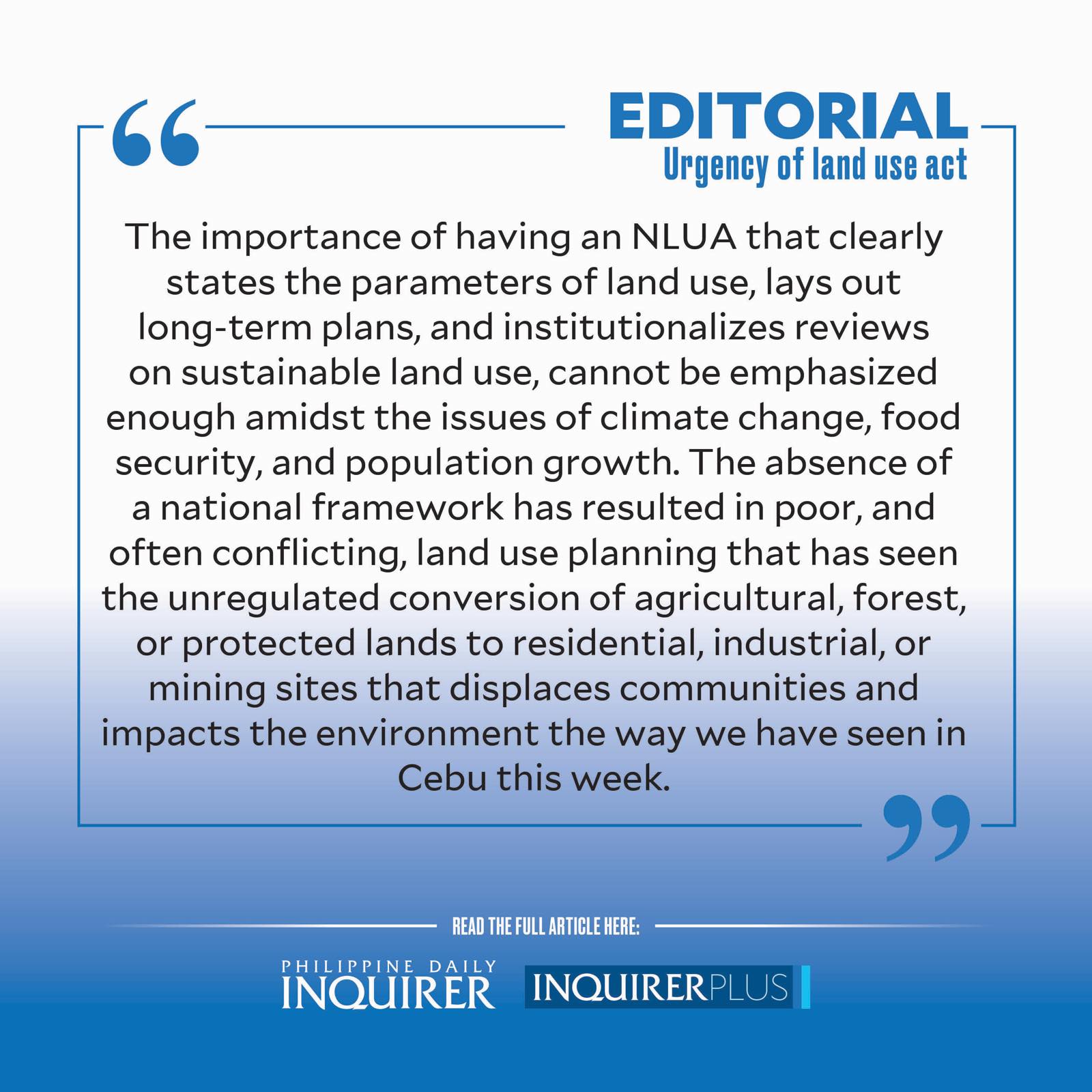Urgency of Land Use Act

The devastation brought about by heavy rains in Cebu and Mandaue cities this week should be a cautionary tale on what unregulated and unsustainable urbanization can do. Major areas in the two cities were transformed into waterways with floods rising to as high as two meters or about 6.5 feet.
Videos that went viral on social media included scenes of a mall’s flooded parking lot and a house being swept away by a landslide. Reports also said that a portion of a major street in downtown Cebu City collapsed due to the heavy rains, creating a sunken area about 15 m long and causing the adjacent concrete fence of Patria de Cebu to collapse; while a wall near the Mahiga Creek also collapsed due to the floods.
These were all caused, not by a typhoon, but by week-long torrential rains resulting in the evacuation of hundreds of families in affected areas and the suspension of classes. The culprit? Poor drainage system and heavy development, according to initial investigation, with a local official noting that waters kept rising because they had nowhere to go and flow as the areas were paved with concrete while existing drainage systems were mostly blocked with silt. The local government has called for short- and long-term solutions to these problems that are not unique to Cebu and are, in fact, replicated across the country, especially in the National Capital Region.
But what makes these floods in Cebu even more significant is that they come on the heels of the controversial “The Rise at Monterrazas,” a high-end development project recently unveiled by social media influencer and engineer Slater Young, that will be built on a mountainside in the Queen City of the South. Critics were quick to point out the irony of building what Young dubbed as a “sustainable residential design” but has the potential of damaging its immediate environment.
The Philippine Institute for Development Studies (PIDS), the country’s leading think tank, published an article by Lorenzo Makoy that raises questions and concerns about the project’s impact on the mountain’s ecology, hydrology, and geology, not to mention the people and communities living in it. The article asked three major questions: How many hectares of trees and the mountainside will they be demolishing to build the condos? Did they compare the volume of rainwater that their irrigation system and tanks can collect compared to the volume of rainwater that the trees and mountainside can collect, with roots absorbing water and the soil storing it? Have they conducted an environmental impact assessment or had one [been] conducted?
Young has assured critics that he has secured all the necessary permits, that the area is residential, and that his project will occupy only a “small, small portion” at the foot of the mountain. They have also conducted a soil profile to ensure that the project site is safe to build on—it is made of “very, very hard” limestone, he said.
However, the questions PIDS raised should be asked not only on high-profile projects but also on all development projects that are being planned or being built. How much of the natural ecosystem is lost for every land that is converted to industrial or residential use? How can soil erosion and liquefaction be prevented for every tree that is felled? How will these development projects impact the immediate environment?
This brings us to the crucial approval of the proposed National Land Use Act (NLUA), which, as Inquirer columnist Cielito F. Habito, noted in a December 2022 column, “has been languishing for nearly three decades now.” Last May, President Marcos renewed his call for Congress to pass NLUA, which is envisioned to integrate all mandates and policies on the use and protection of lands. The President said it should be given the “urgent attention that it deserves,” but made no mention of it in his second State of the Nation Address (the House of Representatives has already passed on third reading last May while the counterpart bill is still pending at the Senate committee level).
The importance of having an NLUA that clearly states the parameters of land use, lays out long-term plans, and institutionalizes reviews on sustainable land use, cannot be emphasized enough amidst the issues of climate change, food security, and population growth. The absence of a national framework has resulted in poor, and often conflicting, land use planning that has seen the unregulated conversion of agricultural, forest, or protected lands to residential, industrial, or mining sites that displaces communities and impacts the environment the way we have seen in Cebu this week. Today, it was a house built on a danger zone that was swept away or an area with no proper drainage system turned into a temporary swimming pool. Tomorrow, it could be an entire village—like what happened during Tropical Storm “Ondoy”—and cities ending up as waterworlds. Must things get worse before action is taken?
If the Marcos administration wants to “Build Better More,” it should aggressively push for the enactment of NLUA as part of its legacy.





















